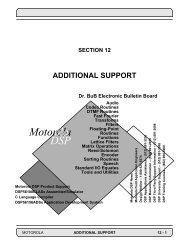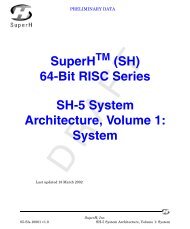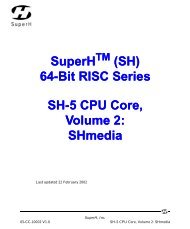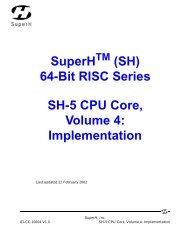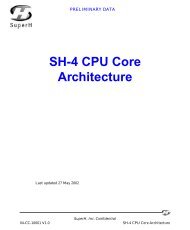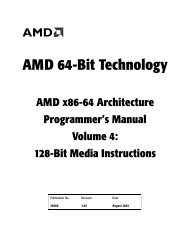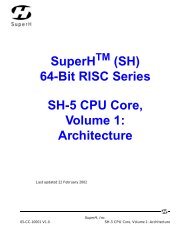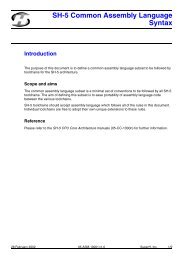SuperH (SH) 64-bit RISC Series SH-5 System Architecture, Volume ...
SuperH (SH) 64-bit RISC Series SH-5 System Architecture, Volume ...
SuperH (SH) 64-bit RISC Series SH-5 System Architecture, Volume ...
You also want an ePaper? Increase the reach of your titles
YUMPU automatically turns print PDFs into web optimized ePapers that Google loves.
PRELIMINARY DATA<br />
218 JTAG interface<br />
Polling out a message<br />
After the five status <strong>bit</strong>s have been shifted out, the tool can determine that an<br />
output message exists and then continues shifting a further 8, 16, 24 or 32 times<br />
depending on which VOMx <strong>bit</strong>s = ‘1’. The tool now has assembled the first bytes of<br />
an output message.<br />
The tool continues this process of shifting out just the IBF and VOMx <strong>bit</strong>s, testing<br />
the VOMx <strong>bit</strong>s and then shifting data <strong>bit</strong>s depending on which VOMx <strong>bit</strong>s = ‘1’. The<br />
detection of any VOMx <strong>bit</strong> = ‘0’ indicates the end of the message. Once the end of the<br />
message has been reached, the tool does not need to shift any more data <strong>bit</strong>s out.<br />
Tool sending a message to <strong>SH</strong>-5<br />
Input messages, longer than 4-bytes, are sent as one or more 4-byte segments<br />
possibly followed by a segment containing fewer bytes. For each 4-byte segment of a<br />
message, the tool shifts 37 <strong>bit</strong>s into TDI with the VIMx status <strong>bit</strong>s in the last<br />
positions (the positions closest to TDI). For the last segment of a message containing<br />
fewer than 4 bytes, the tool shifts 13, 21 or 29 <strong>bit</strong>s into TDI with appropriate VIMx<br />
<strong>bit</strong>s indicating the number of valid bytes.<br />
During message transfers, the first VIMx <strong>bit</strong> = '0' indicates the end of the input<br />
message. When the length of an input message is a multiple of 4 bytes, the end of<br />
the message is indicated by a 1-byte segment (13 <strong>bit</strong>s) with all VIMx <strong>bit</strong>s = ‘0’.<br />
Flow control<br />
The <strong>SH</strong>-5 JTAG tap controller has an input message buffer large enough to hold the<br />
largest input message plus an output message buffer large enough to hold the<br />
largest output message. The DBUS protocol allows one outstanding response in<br />
each direction, so it is possible that the tool may want to send a response message<br />
immediately following a new request. Flow control is needed to eliminate the<br />
possibility of ever having a message in the input buffer overwritten before its has<br />
been moved into the DM. This flow control is done by sending including an input<br />
buffer status <strong>bit</strong> in the DR register, adjacent to the VOM3 <strong>bit</strong>. The tool can poll out<br />
just five <strong>bit</strong>s (if it can handle variable-length shifting), one of which determines<br />
whether the input buffer can accept a new message and the other four determine<br />
whether there is an output message pending.<br />
D R A FT<br />
There is no need for a tool input buffer status <strong>bit</strong> in the other direction. The tool will<br />
only poll <strong>SH</strong>-5 when its input buffer has space for a new message from <strong>SH</strong>-5.<br />
<strong>SuperH</strong>, Inc.<br />
<strong>SH</strong>-5 <strong>System</strong> <strong>Architecture</strong>, <strong>Volume</strong> 3: Debug 05-SA-10003 v1.0



